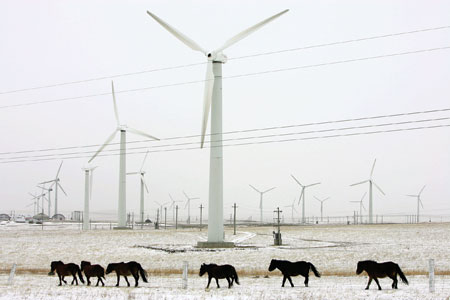The bill on the Renewable Energy Act is expected to be tabled in Parliament before year-end, with the Act coming into force by June next year.
Energy, Green Technology and Water Ministry's Undersecretary of the Sustainable Energy Division, Badriyah Abdul Malek, said the Feed-in Tariff (FiT) mechanism is therefore expected to be implemented at the same time.
FiT is a mechanism that allows electricity produced from indigenous renewable energy resources to be sold to power utilities at a fixed premium price and for specific duration.
"The bill is now completed and submitted to the Attorney-General. So we expect the bill to be tabled for first reading between the October and December session," she told reporters after the Investment Opportunities in Renewable Energy Seminar and Dialogue with Plantation Industries and Commodities Minister Tan Sri Bernard Dompok in Kota Kinabalu today.
"At the same time, we will also table the Sustainable Energy Development Authority (SEDA) Bill, which is to institute the establishment of SEDA Malaysia, the authority to spearhead renewable energy development in Malaysia," Badriyah said.
"We expect the second and third reading in March, and the Act enforced probably in May or June next year, so the FiT will also come on board in May or June 2011," she said.
In response to a question, Badriyah said that for Sabah, it had been estimated that more than 100 megawatts of electricity could be obtained from variable sources such as biomass, biogas and also solar energy.
Concerning the dialogue, Dompok said majority of the 70 participants present from the palm oil industry were waiting for implementation of the Act to see the tariff revised, as the present tariff of 21 sen per unit was considered low.
"That's the general view. The government, of course, will be prepared to look at the increase. But in this area, I am not going to say much more than that because the Energy, Green Technology and Water Ministry will make the necessary announcement," he said.
Dompok said the outcome of today's dialogue also recognised that the oil palm industry could not replace the electricity production from Sabah Electricity Sdn Bhd but it was important to look into renewable energy opportunities to meet the challenges of electricity supply in the state. -- Bernama
| renewable energy resources |
|
Brazil has one of the largest renewable energy programs in the world, involving production of ethanol fuel from sugar cane, and ethanol now provides 18 percent of the country's automotive fuel. As a result of this, together with the exploitation of domestic deep water oil sources, Brazil, which years ago had to import a large share of the petroleum needed for domestic consumption, recently reached complete self-sufficiency in oil.
Brazil is promoting its brand of biofuels because the sugar-to-ethanol process releases a fraction of harmful greenhouse gases and requires only 1/5 of the gas and diesel it makes to produce ethanol from corn. Brazilian ethanol is also produced without official price props or government handouts offered in Europe and the US.
According to a recent article in the Wall Street Journal, Brazil is now producing ethanol for about $1.00/gallon compared with the international price of gasoline of about $1.50/gallon. In Brazil, ethanol is mostly derived from sugar cane, and is now available in 29,000 gas stations throughout the country, and represents about 20 percent of Brazil’s transport fuel market. Brazil’s use of traditional gasoline has actually declined since the late 1970’s.
One of the stimuli behind this move was the termination by the Brazilian government of support for the sugar industry, which forced sugar manufacturers to become more efficient and find other uses for the crop. According to the WSJ, 7 out of every 10 new cars sold in Brazil can use “flex-fuel”, meaning gasoline, ethanol, or a mixture of the two.
Brazil has become so efficient in ethanol production that it expects to double current exports of about $600 million/year to about $1.3 billion by 2010 (most sales are to Sweden and Japan). Ethanol releases less carbon dioxide than gasoline.
The Brazil ethanol model is being looked at by China, India, and the U.S. In the U.S., the most recent energy bill signed into law last August stipulates that the use of ethanol must double by 2012. But U.S. ethanol is made from corn which is about 30 percent more expensive than Brazil’s ethanol. According to WSJ, Henry Ford’s first car was made to run on ethanol.
Brazil’s improvement in ethanol efficiency has come in part due to biotechnology. Brazilian scientists at the Centro de Technologia Canaviera (funded by sugar growers), about 2 hours outside of Sao Paulo and in the heart of the sugar industry, have worked on decoding the DNA of sugar cane. The Center has helped Brazilian growers to select varieties of sugar cane that are more resistant to drought and pests, while at the same time yielding higher sugar content. The Center has developed some 140 new varieties of sugar cane over the last 20 years, which has helped lower the cost of growing sugar cane by about 1 percent/year. Brazilians used to get 2,000 liters (520 gallons) of ethanol out of a hectare (2.5 acres) of sugar cane. That yield has triple to about 6,000 liters/hectare.
Additionally satellite imagery of Brazilian sugar cane fields has helped Brazilian researchers to identify which variety of sugar cane will grow best in different parts of the country, the best time to harvest, and where to situate new fields.
Brazil Ethanol Companies
See: Brazillian Sugarcane Industry Association Website
Ethanol Process


































![Energy consumption in China: past trends and future directions [An article from: Energy Economics]](http://ws.amazon.com/widgets/q?MarketPlace=US&ServiceVersion=20070822&ID=AsinImage&WS=1&Format=_SL160_&ASIN=B000RR32GK&tag=oipainbl-20)

























